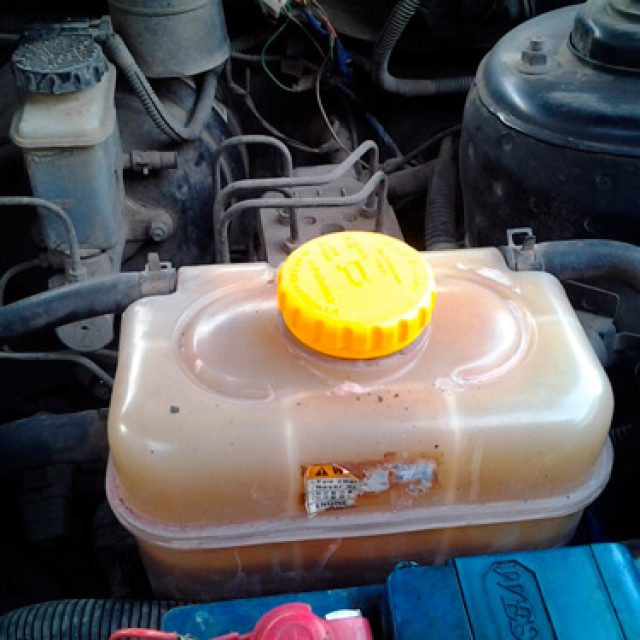Generates a large amount of heat. At the same time, it is important to maintain the temperature of the unit within specified limits for maximum efficient fuel combustion, reducing exhaust toxicity, increasing service life, etc.
In other words, you can’t both cool the engine too much and allow it to overheat. To maintain the required operating temperature, modern engines use a combined system that combines liquid and air cooling.
In the design of a liquid cooling system, an important element is the expansion tank. Next we will talk about what the expansion tank is for, what its main purpose is, and what malfunctions of the expansion tank of the engine cooling system are most common.
What is the purpose of and where is the expansion tank of the engine cooling system located?
So, just open the hood to find the indicated tank. As a rule, this element is always visible so that the driver can easily monitor the coolant level and top up if necessary. On different cars, the tank can be installed to the left or right of the power unit, closer to the engine shield or further from it.
The main function of the tank is to compensate for the changing volume of coolant. This effect occurs as a result of changes in the temperature of the liquid. The design of the cooling system may differ; in some cases, the tank is a simple container for excess liquid, while in others it is a whole device capable of regulating the pressure in the system.
Expansion tank necessary liquid system on modern internal combustion engines. The fact is that coolant (antifreeze, antifreeze) is an aqueous solution based on ethylene or propylene glycol. This liquid has a higher coefficient of thermal expansion compared to water.
Simply put, pour such liquid into the radiator, after the internal combustion engine is heated and it reaches operating temperatures, the liquid will also heat up and expand. It turns out that excess is actually formed, pressure increases, etc.
If you turn off the engine, after the coolant cools down, the volume of liquid decreases again, and a vacuum is created in the system. This causes outside air to be drawn in through the valve in the radiator cap. It is quite obvious that in this case there will be created air jams, which cause heat transfer disturbances, incorrect operation of the cooling system, etc.
To prevent this from happening, a separate container (cooling system tank) is installed into which excess hot coolant from the radiator is collected. Also, the presence of liquid in the tank avoids the creation of vacuum and the formation of air jams, since when the volume decreases as a result of cooling, the liquid from the tank fills the voids.
Today, designers have gone even further by moving the bypass valve, which was previously in the radiator cap, to the expansion tank cap. It turns out that the release of pressure and excess antifreeze when boiling occurs through the tank cap. In other words, the tank took on the function of the upper part of the radiator and ceased to be a simple reservoir.
As mentioned above, the tank can be installed in different places in the engine compartment, however, the location of its installation must be implemented in such a way as to achieve the effect of communicating vessels. The tank and radiator are connected using pipes.
This solution allows access for excess hot antifreeze to the expansion tank. When the coolant cools, it is also possible to compensate for the missing volume in the system by receiving fluid from the tank. This scheme prevents air from entering the radiator and the formation of air locks in the system.
Expansion tank device

Structurally, this container is very simple. The material used is translucent plastic. Also, a sensor can be additionally built into the tank, which signals the driver about a critical decrease in the coolant level.
The top of the tank is closed with a lid in which a valve is installed to regulate the pressure. If the pressure in the system increases, then the valve operates.
Also on the wall of the tank there is a level indicator in the form of “minimum” and “maximum” marks, allowing you to control the liquid level. It is important to understand that on a cold engine the level should not fall below the minimum. The maximum level must also not be exceeded.
As for the tank cap with the valve, it seals the container hermetically on a cold internal combustion engine. However, when the engine reaches operating temperature and the coolant heats up, the pressure in the cooling system and in the tank naturally increases.
If the pressure rise reaches an average of 120 kPa, the valve opens. When the pressure drops to an average of about 83.4 kPa, the valve closes. This operation of the valve is necessary in order to avoid rupture of pipes, damage to the radiator, etc.
At the same time, after the engine cools down, the pressure in the system begins to drop, the volume of coolant decreases and a vacuum is created. When the pressure drops, on average, below 3 kPa, the inlet valve of the expansion tank opens to take in air. As a result, the pressure difference is leveled, and the missing volume of liquid is compensated from the tank.
Common faults

Typically, most problems are not related to the container itself. Not so often there are cases when the tank itself cracks and begins to leak for no obvious reason. However, even taking into account the simple design, the problem part may well be the cap of the expansion tank of the engine cooling system.
The valve built into the lid may fail. Insufficient sealing may also occur due to deformation of the rubber ring. As a result of such malfunctions, the cap may begin to leak antifreeze, the system may become airy, etc.
If the valve in the cover begins to work incorrectly, then in such a case deviations in the operation of the internal combustion engine cooling system are inevitable. In addition to the formation of air locks, this situation in some cases leads to a critical increase in pressure and rupture of the expansion tank. In such a situation, the tank needs to be replaced with a new one. It is not recommended to attempt to restore a damaged container by sealing cracks.
If we talk about the cover, its damage and defects, as well as malfunctions of the valves due to clogging or deterioration, are a reason to replace the cover. In some cases, the lid is cleaned in an attempt to restore functionality, but this method does not always work. Given the low cost, it is better to replace the element immediately.
What's the result?
As you can see, in the design of a modern car, increased demands are placed on the engine cooling system and its correct operation. For this reason, for efficient operation, a special tank is additionally used in the design.
You also need to know that if the specified expansion tank of the engine cooling system is involved in the circuit, it is highly advisable to fill the system only with antifreeze or antifreeze, and not water. As for breakdowns, if pressure increases in the cooling system or air pockets form, special attention must be paid to the expansion tank cap.
Malfunction of the valves in the cover often leads to damaged pipes, the thermostat fails faster, the pump suffers, the engine may overheat, etc.
The expansion tank is a necessary element of a liquid cooling system. It serves to compensate for the change in volume characteristic of any liquid when the temperature changes. Depending on the design of the system, it can be either a simple reservoir for excess liquid or an element that regulates pressure in the cooling system.
What is an expansion tank used for?
The coefficient of thermal expansion of such liquids, which are based on an aqueous solution of propylene glycol or ethylene glycol, is much higher than that of water. If antifreeze or antifreeze is poured into cold radiator“under the neck”, then when the engine is turned on and the thermal expansion of the coolant, its excess appears. Liquid through safety valve is squeezed out of the radiator and enters a primitive expansion tank, which serves as a reservoir for excess antifreeze.Propylene glycol, which forms the basis of antifreeze and antifreeze, is the main element of liquid for electronic cigarettes.
When the engine is turned off and cooled, the volume of liquid in the radiator decreases and a vacuum occurs in the cooling system. The radiator cap valve opens and air is sucked into it. There is a danger of air pockets in the “cooling jackets”. This can lead to disruption of the heat exchange process and overheating of the motor. Therefore, there was a need for an additional reservoir for liquid that would enter the radiator instead of air. The expansion tank became such a reservoir. There are systems in which the bypass valve, which allows the release of excess steam and even excessively hot coolant, is not located in the radiator cap. In this case, the expansion tank acts as the upper part of the radiator and is included in the cooling system as an important element.
Location and design of the expansion tank
Expansion tanks are made mainly of transparent plastic. During manufacturing, a special shackle is applied to the side wall, which allows you to monitor the level of coolant in the system. The lower mark on the side surface indicates the minimum permissible fluid level. The maximum level of coolant in the tank when the engine is cold should be 25-30 mm above the top mark marked on the side of the expansion tank.When calculating cooling systems, it is customary to leave approximately 1/20 of the total volume of liquid for thermal expansion. This is how much antifreeze can fit between the Min and Max marks
The expansion tank is located next to the radiator and is attached directly to the car body. The middle of the tank and the upper edge of the radiator are located at the same level - according to the principle of communicating vessels. Using a hose located at the bottom of the expansion tank, it is connected to. This design allows excess heated coolant to enter the tank. And when the engine cools down, it compensates for the volume of liquid in the system from its contents. This process prevents air from entering the radiator.
Typical malfunctions of the expansion tank
The most common breakdowns are rightly considered to be leakage or rupture of the expansion tank. Leakage may be a consequence of a violation of the integrity of its body or a defect in the connecting hose. The result of a rupture of the expansion tank can be a catastrophic drop in the volume of coolant. This may cause the engine to overheat. If this happens, you must immediately stop and replace the damaged element and replenish the fluid volume. It should be remembered that adding cold liquid to the cooling system is strictly prohibited, as this can lead to the formation of cracks in the cylinder head or in the cylinder block itself.Many people know that a car heats up during engine operation and requires constant cooling, especially in the hot season. Absolutely every car has a cooling system installed. An integral part of this system is the expansion tank. It serves to allow excess and spent steam to escape into it. You can add coolant through the reservoir cap and monitor its condition if there is no special sensor.
What is this tank?
First you need to determine what an expansion tank is and what it does in the operation of the car. Most often this is a plastic container with hoses coming out of it. It is often equipped with a sensor that shows the coolant level. This plastic container is screwed on with a lid in which a valve is installed.
The valve serves to regulate the pressure in. The fact is that this system is completely sealed and when heated, increased pressure is created, which accumulates in the expansion tank, because it is highest point the entire system.
When pressure accumulates, a valve installed in the lid releases excess air. As the car cools, the pressure decreases, and the same valve sucks the required amount of air into the system.
This cover must be properly maintained, otherwise it will not perform as well.
Basic functions of the tank
The main function of the reservoir is to remove excess coolant and excess pressure for storage while the engine warms up. This happens due to the fact that during heating the volume of liquid and pressure in the entire system increases. Due to heating, the liquid expands, the pressure increases and begins to rise to the top point of the system according to the same principle as in the heating system of a house.
The highest point of the system, as already mentioned, is this same expansion tank. It should be noted that the liquid increases only while it is heated by the engine; after it cools down again after stopping the engine, it will all drain into the radiator. In order not to overfill the liquid, there are special marks on the body of this plastic container. You need to fill according to the following principle. You cannot fill liquid above the maximum mark and below the minimum mark, this can lead to various problems.
The second function of this device is to remove steam that accumulates as a result of evaporation of liquid. This is done by the lid, which has a special valve that, if necessary, releases and sucks in air.
There are also cooling systems in which the radiator cap is responsible for releasing air and excess heated antifreeze or antifreeze. In such engine cooling systems, the expansion tank is not considered an important part.
Tank malfunctions and their elimination
The most basic malfunction is considered to be leakage of this tank. There may be several reasons for this malfunction.
- It often drips at the hose connections. In order to eliminate this malfunction, you just need to replace the clamp or the entire hose. In order to replace the clamp, no special effort is required, and this can be done even in the yard, but in the case of a hose it will be a little more difficult.
- The second reason for liquid leakage may be a broken tank. A hole in the tank may occur due to improper handling or impact of the housing. Also, the body of the tank could be pierced if the lid does not work properly and does not bleed air, which is why the tank expanded and cracked either at a seam or in a weak spot. In order to eliminate this malfunction, you need to purchase a new tank and install it. It is worth paying attention to the fact that if you solder the expansion tank, then next time the same thing will happen to the system, only with more dire consequences.
The second malfunction is considered to be a non-functioning valve in the lid; this can only be corrected by replacing it with a new one. In order to replace it, it does not require much effort and time, you just need to purchase a new cover and screw it in place of the old one.

It is worth paying attention to the fact that this should only be done on a cooled car, otherwise you may get burned.
Summing up
After reading this article, you can learn a few lessons for yourself and not repeat the mistakes that other car owners have made. The main thing to know is that new coolant should only be poured onto a cooled engine, otherwise this may lead to deformation of the engine itself or the cooling system.
You should also constantly pay attention to the cooling system and constantly look at the readings of the sensors, and if they are not there, then often unscrew the reservoir cap and monitor the pressure. Proper care and constant monitoring of the performance of all components of the car can contribute to rare visits to car service centers and spare parts stores. There is no principle of communicating vessels, so the liquid rises to the top.
Drivers know that coolant is stored in the car's expansion tank, without which the engine will not work for a long time. On top of the expansion tank there is a neck through which antifreeze is poured. To prevent it from spilling out when the car is moving, the neck is closed with a lid. It may seem that its structure and tasks are quite simple, but this is not entirely true. The expansion tank cap is an extremely important element of the engine, which must be monitored so that expensive engine components do not fail.
Table of contents:Tasks of the expansion tank cap
 Engine operation is accompanied by heating, which is quite natural, given the processes taking place in it. As the engine components heat up, the coolant also heats up, which takes away some of the heat. An increase in liquid temperature is accompanied by its expansion and increase in pressure. Accordingly, the more the engine warms up, the greater the pressure that appears in the cooling system where the antifreeze or antifreeze is located. To prevent rupture of pipes, radiator, pipes and other elements of the cooling system when pressure increases, an expansion tank cap is needed, which not only performs a locking function, but also acts as a valve.
Engine operation is accompanied by heating, which is quite natural, given the processes taking place in it. As the engine components heat up, the coolant also heats up, which takes away some of the heat. An increase in liquid temperature is accompanied by its expansion and increase in pressure. Accordingly, the more the engine warms up, the greater the pressure that appears in the cooling system where the antifreeze or antifreeze is located. To prevent rupture of pipes, radiator, pipes and other elements of the cooling system when pressure increases, an expansion tank cap is needed, which not only performs a locking function, but also acts as a valve.
A warm engine operates at different temperatures. For some cars, the normal value is 95-100 degrees Celsius, for others the value reaches 125-130 degrees, and these indicators are also not maximum. At such temperatures, the coolant expands by approximately 20-30%, and accordingly, serious overpressure occurs. It is generally accepted that normal pressure in a car’s cooling system is 1.1-1.5 atmospheres, and if it is exceeded, problems may begin. Unpleasant situations also arise when the vehicle pressure is low, which is manifested by the creation of a vacuum inside the system and compression of pipes, hoses and other elements.
A properly functioning expansion tank cap eliminates the possibility of high and low pressure in the system, due to which it remains at the required level.
How the expansion tank cap works and works
 Since the main tasks of the cap are to create the necessary pressure in the system and retain coolant in it, it must fit tightly to the edges of the tank onto which it is screwed.
Since the main tasks of the cap are to create the necessary pressure in the system and retain coolant in it, it must fit tightly to the edges of the tank onto which it is screwed.
A pressure regulating valve is built inside the direct cover. It plunges into the expansion tank and performs the task of releasing or pressurizing, depending on the need.
Note: In modern foreign cars, one physical valve is responsible for the functions of bleeding and pressurizing, while on old Russian cars there are two valves, each of which copes with its task.
As long as the pressure in the cooling system is within normal limits, the valves on the expansion tank cap do not operate. As soon as the pressure goes beyond the limit values, they perform one or another function.
Signs of a faulty expansion tank cap

It is quite difficult to identify a malfunction of the expansion tank cap, and serious malfunctions with engine components can occur due to problems in the operation of the valve. The following main symptoms of a malfunction can be identified:
- Smoke from under the hood. Most often it appears when coolant hits a hot intake manifold. In such a situation, the engine temperature will be at normal level. The problem manifests itself when the valve malfunctions, which should lower the pressure when it is exceeded. It begins to release pressure before peak values, which leads to a splash of antifreeze;
- Engine overheating due to cold air from the heater. If such a symptom is present, it indicates a failure of the low pressure valve. Due to problems with it, air jams will occur in the cooling system, which will lead to overheating of the engine.
Also, symptoms of a malfunction of the expansion tank cap can be considered failure of clamps, rupture of tubes, radiator and other elements of the cooling system, including the tank itself. If traces of coolant begin to appear on the connecting elements, this indicates excess pressure in the system and the need to replace the expansion tank cap.
How to check the expansion tank cap
Checking the expansion tank cap is a rather complicated procedure, given that its operation directly depends on pressure, which is not so easy to create. IN service centers There are pressure pumps capable of pumping the required number of atmospheres, after which you can check whether the valve operates or not.
As for checking the expansion tank cap yourself, it is less accurate in terms of results, but it allows you to detect a fault in most cases. The cover is checked as follows:

Another way to check the expansion tank cap, which cannot always be used due to various designs engines and cooling system hose routes. It involves unscrewing the cap and squeezing one of the thick hoses. After this, the lid is screwed into place. The compression point of the hose is released, and if it returns to its original shape, then there are no problems with the valve in the cover.
How many interesting articles have been written about thermostats, pumps, radiators... But the expansion tank received only passing attention. But when you are desperately struggling with air jams in winter in order to get the heater in your car to work, or you are wondering why suddenly the arrow on the engine temperature sensor is desperately approaching the red limit or does not reach the working limit, do you think about why this happens, and what is the reason... Therefore, today we will talk about what troubles are hidden in the expansion tank, and how to avoid them.
What is an expansion tank?
Expansion tank with a closed lid This is a kind of plastic container with rubber hoses, with or without a coolant level sensor, as well as a pressure bypass valve built into the plastic lid. It is with this most insignificant detail at first glance, like a lid with a valve, that we will deal.
Why is she even needed? It's all about the coolant. The operating temperature of engines from domestic manufacturers, as a rule, is 90-95 C, and in order for the coolant not to boil while circulating in the system, its boiling point must be much higher, approximately 130 C. Therefore, coolant is initially created with elevated temperature boiling.
Also very important is maintaining high blood pressure in the engine cooling system (ECS), greater than atmospheric pressure, since pressure is a necessary condition for increasing the boiling point.
The working pressure in the OSD of domestic cars is, as a rule, 1.0 kgf/cm2, and of imported cars - about 1.5 kgf/cm2. Since the efficiency and operating temperature of imported car engines is higher and equals approximately 100-105 C, the pressure in the system should be higher.
“What does a cap in the expansion tank actually have to do with pressure?” - you ask. The most direct...
Operating principle of the expansion tank cap

Expansion tank, exhaust valve. When the engine heats up, the coolant also heats up. In this case, since the SOD is absolutely sealed, excess pressure is created. The entire SOD begins to expand, and excess air accumulates at its highest point - the expansion tank. Next, under the influence of compressed air, the outlet valve of the expansion tank opens and excess air escapes.
When the engine cools down, the reverse process occurs. The pressure in the system drops, and in order to avoid decompensation, that is, a decrease in the pressure level in the tank below atmospheric pressure, the inlet valve opens and sucks air into the system.
It often happens that drivers do not pay special attention to this small cap. As a result, gradual clogging and even corrosion occurs. The valve stops functioning correctly.
Consequences of incorrect operation of the expansion tank cap valves

If the valve in the tank has rusted and crumbled, then the tightness of the entire SOD is compromised. Excess air begins to freely enter and leave the system, forming air jams. Which, in turn, provoke engine overheating, depressurization of the SOD, failure of its parts and non-functioning stove in winter.
If the valve is clogged, it will also not function. This leads to the formation overpressure, and, as often happens, depressurization of the SOD. If it is completely depressurized, the pipes are torn off, which can lead to the engine boiling. If it is partial, radiators leak, seals leak, pipe clamps become loose, the thermostat and, less often, the pump fail, etc.
The correct operation of the valve can be checked very simply. First, inspect it, and if you don’t notice any dirt or rust, then just press it with your finger. When the internal plastic valve is working properly, you will hear a sucking sound when you release the valve when you hold the cap to your ear, and a whistling sound of air escaping when you press down.
So, from all of the above we want to draw a conclusion. As popular wisdom says: “The spool is small, but expensive.” Do not neglect such a small but very important detail as the cap of the expansion tank of the engine cooling system. By periodically looking under it, you will be able to avoid many subsequent problems. Good luck on the road!




